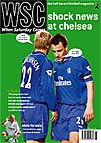 Dianne Millen explores the potential pit falls of a groundshare bewteen two rivals
Dianne Millen explores the potential pit falls of a groundshare bewteen two rivals
Groundsharing controversies – you go years without them and then two come along at once. After the Falkirk saga comes the controversial announcement that Hearts and Hibs are proposing to sell their grounds, both in traditional working-class areas of the city, to fund a purpose-built stadium miles out of town in Straiton, an area currently best known for hosting the local Ikea.
Although both clubs insist the deal is far from done, reports suggest the landowning consortium – which includes reclusive Hibs owner Tom Farmer – have already agreed not to charge for the site of the £20 million development, which they hope will be part-funded by the council.
Despite Hearts’ claims that they have no choice but to move from ageing and non-UEFA compliant Tynecastle, the real driver for the plan is the chance to pay off the clubs’ combined debts of £27m. Whether or not you agree with the chairmen that reduced television revenue and soaring costs have put them in this position, or take the more cynical view that they’ve poured most of the cash into the pockets of underperforming players, the capital clubs are uniquely positioned to profit. Both stadiums are in prime locations and the prices currently being paid by developers in the overheated Edinburgh market means the deal could realise around £50m, more than enough for both to clear their debts and still have cash to blow on players.
Some reactions have acknowledged the potential for gains on the pitch, in accordance with Hearts chairman Chris Robinson’s ambitious hope of Hearts and Hibs one day following the Milan clubs in contesting the Champions’ League semi-final at their new ground (how typically Scottish not to dream of the actual final). However, the general mood has been of reluctance and opposition.
The practical implications of playing at Straiton have attracted criticism from fans unwilling to travel, local environmental activists and transport analysts concerned about the inadequate local road network. The plan has also, perhaps inevitably, reawakened the endemic paranoia about merger which affects any multi-club area but is particularly strong among capital fans still jumpy about former Hearts chairman Wallace Mercer’s failed attempt in 1990.
Even those who aren’t suspicious that the ultimate agenda is to create a self-assembly Edinburgh United have reacted from the heart. A swell of emotional attachment to Easter Road and Tynecastle, to established pre-match rituals, to the cross-town sting of derbies, to the very stands in which fans have sat for generations (and which both clubs have spent fortunes on redeveloping), has surfaced. The lack of atmosphere at other out-of-town stadiums such as St Johnstone’s McDiarmid Park in Perth has also been cited.
Although several clubs are facing similar issues as they consider stadium redevelopment, ultimately the Straiton plan may come to symbolise the overcrowded capital’s struggles with gentrification. The new homes built nowadays in inner-city districts such as Leith (Hibs) and Gorgie (Hearts) are super-expensive, lifestyle-supplement apartments, well beyond the wallets of local families. The exporting of football would be final confirmation of the upmarket inner city the council and developers want to create, in which the indigenous working class are no longer welcome.
Recognising the tensions, both clubs have assured fans their views will count: Hibs have named iconic ex-player Pat Stanton as liaison and commissioned consultants to collect feedback; Hearts are using existing fan consultation channels. But the months ahead will reveal just how seriously all concerned are prepared to take two hundred years of tradition in the light of the sheer loot involved.
But while Hearts and Hibs seek to win over hearts and minds, it is to be hoped the game’s authorities will recognise this as more than just a local planning issue. They must look at how the Scottish game has got into the situation where clubs are selling off non-playing assets just to survive the consequences of their own mismanagement and be collectively prepared for what might happen if they get into debt again with nothing left to sell.
The rest of the SPL should also take an interest. Although clubs have the right to dispose of their assets as they wish, the unrivalled spending power of the Glasgow giants means everyone else is challenging for third place. A cash-rich, debt-free capital twosome might reduce what little competition remains still further. Although there is a long way still to go, if fifth place ever becomes the only realistic target for the other SPL clubs then their fans may as well start spending their Saturdays in Straiton too. At Ikea.
From WSC 198 August 2003. What was happening this month